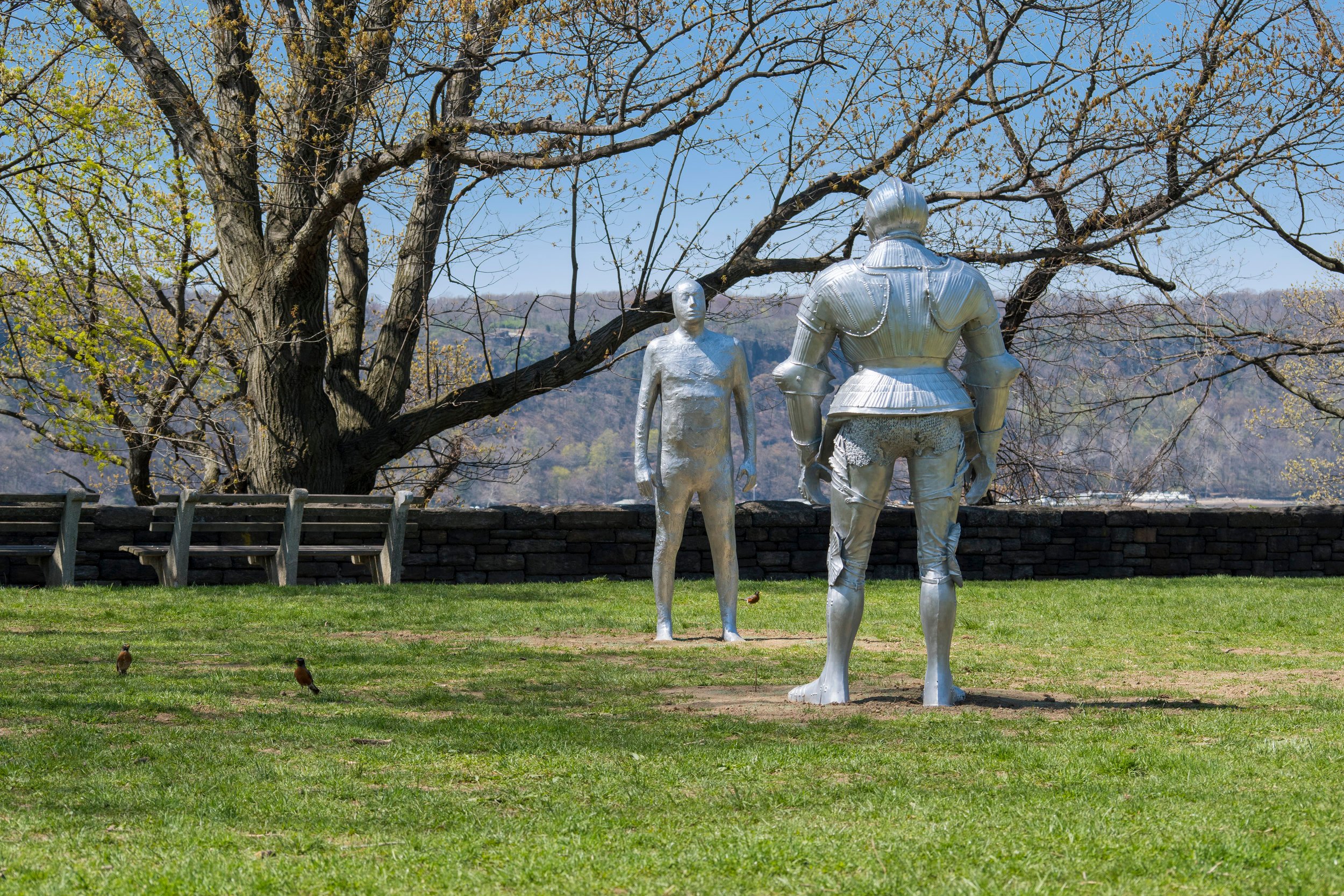
Visitors to New York’s Cloisters just might meet their knight in shining armor this summer. A new public art installation from Icelandic artist Steinunn Thorarinsdottir is bringing life-size copies of real suits of armor from the Metropolitan Museum of Art’s Medieval collection to the Cloisters Lawn in Fort Tryon Park.
To create the sculptures, the artist teamed up with the Met’s Advanced Imaging Department to create 3-D scans of three suits of armor from the collection. First, the suits were 3-D printed, then reproduced in cast aluminum by a foundry in China using the lost wax method—an impressive blend of modern-day technology and age-old techniques.
The idea for the project came to Thorarinsdottir about five years ago during an extended stay in New York, when she developed a fascination with the arms and armor department at the Met. “I started to think about how to incorporate armor into my figurative visual work,” the artist told artnet News at the show’s opening reception.
Steinunn Thorarinsdottir with a sculpture from her exhibition “ARMORS” at Fort Tryon Park. Photo by Sarah Cascone.
Each armored statue faces off with an androgynous figure, a recurring motif in Thorarinsdottir’s work. They are cast using bandage molds from the body of her son, who has doubled as her model since 1997. For each of the three sculptural pairs, he stood the same way the suit of armor was posed, mimicking the Medieval warrior’s frozen stance. (In contrast to these artifacts of war, Thorarinsdottir’s son is actually a pacifist.)
Juxtaposing “the vulnerability of the naked figure and the power of the armor” seemed like the perfect starting point for a public art installation, Thorarinsdottir recalled. “Two years ago, I thought, ‘I have to make it a reality because it’s stayed with me for so long.'”
Having previously been the subject of an exhibition with the New York City Department of Parks and Recreation across from the UN in 2011, she approached Art in the Parks with the idea. Jennifer Hoppa, the Northern Manhattan Park Administrator, immediately jumped at the chance, suggesting Fort Tryon Park as the perfect location. “We have an incredible Medieval collection here, so it was a good fit,” she said.
Steinunn Thorarinsdottir, “ARMORS” at Fort Tryon Park. Photo by Azhar Kotadia.
Although Thorarinsdottir had not previously visited the site, but she was easily won over by the verdant green lawn situated beneath the watchful eye of the Cloisters, an architectural marvel constructed from several authentic Gothic chapels shipped over, stone by stone, from Europe in the mid-to-late 1930s.
Also quick to come on board was the Met. Curator Donald La Rocca did a walk-through of the arms and armor display with Thorarinsdottir, pointing out the pieces he thought best lent themselves to her project. She was pleased to discover that she had earmarked the very same three armored suits when she first conceived the idea back in 2013.
Steinunn Thorarinsdottir used these three suits of armor from the Metropolitan Museum of Art’s Arms and Armor collection as the basis for her exhibition “ARMORS” at Fort Tryon Park. Photo courtesy of the Metropolitan Museum of Art.
Next came the museum’s Advanced Imaging Department, which gained experience scanning objects from its collection for artists’ reproduction ahead of Adrián Villar Rojas’s “The Theater of Disappearance,” the museum’s rooftop commission for 2017. Normally, the museum scans artifacts for conservation purposes—for instance, to create mounts for display—on an as-needed basis. (There are currently no plans to systematically scan every object in the collection.)
“This is fun because this is an artistic problem to solve,” Scott Geffert, the general manager for the imaging department, told artnet News.
Indeed, the many interlocking parts in a suit of armor are quite challenging to scan accurately. “If you were in a perfect world you could scan each piece and put it together, and you would have a lot more control,” Geffert explained. As it was, the suit stayed on a mannequin, which meant the imaging lab team had to start over every time the armor so much as jiggled, shifting the alignment of the pieces.
Steinunn Thorarinsdottir, “ARMORS” at Fort Tryon Park. Photo by Azhar Kotadia.
“If you asked someone to scan armor they’d probably say no,” Geffert admitted.
Seeing the work for the first time after completing the scans, he was pleased with the finished product. “From a 3-D scan of high resolution, to a 3-D print to a wax mold to cast aluminum—that’s incredible to hold that level of detail,” Geffert added. “I was expecting something much more low-res with all those iterations. Technically, I’m very impressed.”
Thorarinsdottir is also happy with the final works, which sparkle on the sunlit lawn from their perch overlooking the Hudson. “It’s totally different from behind the glass at the Metropolitan,” she said.
See more photographs from the exhibition below.
Steinunn Thorarinsdottir, “ARMORS” at Fort Tryon Park. Photo by Sarah Cascone.
Steinunn Thorarinsdottir, “ARMORS” at Fort Tryon Park. Photo by Sarah Cascone.
Steinunn Thorarinsdottir, “ARMORS” at Fort Tryon Park. Photo by Sarah Cascone.
Steinunn Thorarinsdottir, “ARMORS” at Fort Tryon Park. Photo by Azhar Kotadia.
Steinunn Thorarinsdottir, “ARMORS” at Fort Tryon Park. Photo by Azhar Kotadia.
Steinunn Thorarinsdottir, “ARMORS” at Fort Tryon Park. Photo by Azhar Kotadai.
“Steinunn Thorarinsdottir: ARMORS” is on view at Fort Tryon Park, Margaret Corbin Drive, New York, May 9–September 12, 2018.